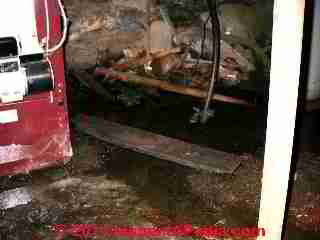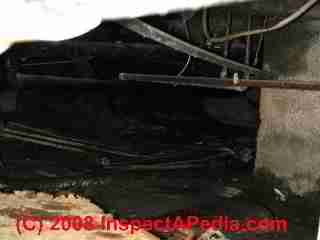 Crawl Space Waterproofing
Crawl Space Waterproofing
How to Prevent Crawl Space Water Entry
- POST a QUESTION or COMMENT about how to dry out a wet crawl space & prevent future crawl space water entry
Prevent future crawl space water entry by crawl space waterproofing methods:
How to keep water from entering a building crawl space in the first place.
Here we summarize the approach to preventing water from leaking into a building crawl area. The place to start is with an outside inspection for sources of leaks into the crawl area, but we also discuss using a sump pump to lower the water table under and around the building.
InspectAPedia tolerates no conflicts of interest. We have no relationship with advertisers, products, or services discussed at this website.
- Daniel Friedman, Publisher/Editor/Author - See WHO ARE WE?
How to Keep Out Crawl Space Water & Moisture - Exterior Measures for Crawl Space Moisture Control
 We noted earlier that it is almost always preferable to keep water from entering a building rather than allowing it to enter and then working to get rid of it.
We noted earlier that it is almost always preferable to keep water from entering a building rather than allowing it to enter and then working to get rid of it.
Here we refer to articles giving more detail on measures to keep unwanted roof runoff or surface or even subsurface water from entering a basement or crawl space.
[Click to enlarge any image]
Inspect the roof drainage system, gutters and downspouts to be certain that roof spillage is not ending up by the building foundation.
Defects in handling roof runoff is the number one source of basement and crawl space dampness and water entry.
Start outside the building: inspect the building roof drainage system and surface grading to be sure that roof runoff is not spilling where it is trapped against the crawl space foundation walls.
The articles listed just below provide ample detail for more complete water entry source, cause & cure investigation for a crawl space.
Key building water entry diagnosis and cure articles:
- BASEMENT WATERPROOFING - use of sealers to help keep basements and crawlspaces dry
- BASEMENT LEAKS, INSPECT FOR - where and how water gets into basements and crawl spaces
- CRAWL SPACE DRYOUT - home - details about curing wet or damp crawl spaces.
- EFFLORESCENCE SALTS & WHITE DEPOSITS - these white deposits are a great indicator of where moisture is penetrating a foundation
- HUMIDITY CONTROL & TARGETS INDOORS - so how dry should a building be for comfort and mold prevention?
- MOISTURE CONTROL in BUILDINGS - master list of detecting and controlling building moisture levels
- MOISTURE METER STUDY - reliability of methods for screening buildings for leaks, water, moisture, mold
- MOISTURE PROBLEMS: CAUSE & CURE - moisture and building energy loss
- SUMP PUMPS GUIDE - how and where to install a sump pump as an emergency backup against basement or crawl space flooding
- WATER ENTRY in BUILDINGS catalogs all of the steps you should consider in keeping water from entering a building basement or crawl space. Just about every step you would take to prevent basement water entry applies to preventing crawl space water entry.
- WET BASEMENT PREVENTION - how to stop basement flooding.
How to Install & Use Sump Pumps in Crawl Spaces
 In a crawl space where there is standing water, dehumidification and dry-out efforts will be ineffective. We need first to get rid of standing water and second (as discussed previously) keep water from entering the crawl area.
In a crawl space where there is standing water, dehumidification and dry-out efforts will be ineffective. We need first to get rid of standing water and second (as discussed previously) keep water from entering the crawl area.
Watch out: as we detail at CRAWL SPACE SAFETY ADVICE, entering a wet crawl area is dangerous, involving shock hazards and possible chemical or sewage contaminants.
And see our complete list of crawl space dryout steps at
CRAWL SPACE DRYOUT
It's always better to keep water out of buildings than to let it come in and then try to get rid of it. But some building sites and conditions may still justify one or more sump pumps in the crawl space. Earlier we stressed the importance of making sure that the crawl space floor drains to one or more points where as sump pump can be installed if needed.
Not like this! We cannot show all of the ways to foul up a sump pump installation in one article, but our photo at left is particularly disgusting. Don't just throw a sump pump into a low area in the floor. The resulting lake will continue to damage the rest of the building.
A sump pump can, by lowering the water table under a crawl space floor, reduce the chances of water entering the crawl space through the lower foundation walls or floor. We have used this method with success in areas of seasonally wet soils, but we would not add a sump pump installation to try to dry out a crawl area (or basement) before first fixing all outdoor water entry sources possible.
Otherwise you may find you are simply cycling water: pumping it out of the crawl area only to have the same water cycle back into the structure.
At SUMP PUMPS GUIDE we discuss types of sump pumps and how they should be connected to electrical wiring and to drainage destinations. Keep in mind that the time you are most likely to need a crawl space sump pump is during hurricanes or tropical storms or in northern climates during times of heavy snow melt.
During a storm is just when electrical power may be lost. If your electrical power is not reliable you should consider a battery-operated backup sump pump system with enough capacity to keep the pump(s) running until power is restored.
Also see MOLD CLEANUP - MISTAKES to AVOID for a master list of the principal ways that people foul up mold cleanup projects.
...
Continue reading at CRAWL SPACE GROUND COVERS or select a topic from the closely-related articles below, or see the complete ARTICLE INDEX.
Or see these
Recommended Articles
- CRAWL SPACE CLEAN UP
- CRAWL SPACE DEBRIS
- CRAWL SPACE DISINFECTANTS & SANITIZERS, SOURCES
- CRAWL SPACE DRYOUT - home
- CRAWL SPACE INSULATION RETROFIT
- CRAWLSPACE MOLD ADVICE
- CRAWL SPACE SAFETY ADVICE
- CRAWL SPACE SEWAGE CLEANUP
- CRAWL SPACE VAPOR BARRIER LOCATION
- CRAWL SPACE VENTILATION CODES
- CRAWLSPACE MOLD ADVICE
Suggested citation for this web page
CRAWL SPACE WATERPROOFING at InspectApedia.com - online encyclopedia of building & environmental inspection, testing, diagnosis, repair, & problem prevention advice.
Or see this
INDEX to RELATED ARTICLES: ARTICLE INDEX to CRAWL SPACES
Or use the SEARCH BOX found below to Ask a Question or Search InspectApedia
Ask a Question or Search InspectApedia
Try the search box just below, or if you prefer, post a question or comment in the Comments box below and we will respond promptly.
Search the InspectApedia website
Note: appearance of your Comment below may be delayed: if your comment contains an image, photograph, web link, or text that looks to the software as if it might be a web link, your posting will appear after it has been approved by a moderator. Apologies for the delay.
Only one image can be added per comment but you can post as many comments, and therefore images, as you like.
You will not receive a notification when a response to your question has been posted.
Please bookmark this page to make it easy for you to check back for our response.
Comments

IF above you see "Comment Form is loading comments..." then COMMENT BOX - countable.ca / bawkbox.com IS NOT WORKING.
In any case you are welcome to send an email directly to us at InspectApedia.com at editor@inspectApedia.com
We'll reply to you directly. Please help us help you by noting, in your email, the URL of the InspectApedia page where you wanted to comment.
Citations & References
In addition to any citations in the article above, a full list is available on request.
- [1] Harriet Burge, Harvard School of Public Health, and EM Laboratory, a private mold and environmental testing lab - email to D.F. August, 2004. Dr. Burge is an educator, writer, and consultant in the field of indoor air quality and mold contamination.
- [2] Product literature and MSDS sheets for the biocides and fungicidal sealants listed in this article.
- [3] US Centers for Disease Control, CDC: www.cdc.gov/ncidod/diseases/hanta/hps/ describes the risks associated with hantavirus.
- [4]U.S. City or State Adopted versions of the model buiding code produced by ICC Section R408, Under Floor Space, http://publicecodes.cyberregs.com/icod/irc/2012/icod_irc_2012_4_sec008.htm, retrieved 3/2/2013
See these City or State Adopted versions of the model buiding code produced by ICC Section M1305.1.4 [PDF] Section M1305.1.4 for access requirements where mechanical equipment is located under floors. - [5]U.S. City or State Adopted versions of the model buiding code produced by ICC Section R406, Foundation Waterproofing and Dampproofing, http://publicecodes.cyberregs.com/icod/irc/2012/icod_irc_2012_4_sec006.htm, retrieved 3/2/2013
- Thanks to reader C. Brown for suggesting the need for detail about rapid dryout procedures for a wet crawl space
- Fiberglass: Indoor Air Quality Investigations: Health Concerns About Airborne Fiberglass: Fiberglass in Indoor Air from HVAC ducts, and Building Insulation
- HUMIDITY CONTROL & TARGETS INDOORS What indoor humidity should we maintain in order to avoid a mold problem?
- How to Clean Moldy Wood Framing & Sheathing How to clean/seal mold from/on exposed lumber or plywood subfloor or roof sheathing indoors - some suggestions based on our field and laboratory research
- How to Find and Test For Mold in buildings A "how to" photo and text primer on finding and choosing the right spots to test for mold in buildings
- Stuff that is not mold but is often mistaken for it - things you may not want to test. Also, not all "black mold" is toxic - here are examples of harmless black mold.
- Mold-Resistant Building Practices, advice from an expert on how to prevent mold after a building flood and how to prevent mold growth in buildings by selection of building materials and by anti-mold construction details.
- WEATHER RESISTIVE BARRIERS [PDF] U.S. Department of Energy, ", how to select and install housewrap and other types of weather resistive barriers
- Asbestos: How to find and recognize asbestos in buildings - visual inspection methods, list of common asbestos-containing materials
- Asbestos Identification and Testing References
- Asbestos Identification, Walter C.McCrone, McCrone Research Institute, Chicago, IL.1987 ISBN 0-904962-11-3. Dr. McCrone literally "wrote the book" on asbestos identification procedures which formed the basis for current work by asbestos identification laboratories.
- Stanton, .F., et al., National Bureau of Standards Special Publication 506: 143-151
- Pott, F., Staub-Reinhalf Luft 38, 486-490 (1978) cited by McCrone
- In addition to citations & references found in this article, see the research citations given at the end of the related articles found at our suggested
CONTINUE READING or RECOMMENDED ARTICLES.
- Carson, Dunlop & Associates Ltd., 120 Carlton Street Suite 407, Toronto ON M5A 4K2. Tel: (416) 964-9415 1-800-268-7070 Email: info@carsondunlop.com. Alan Carson is a past president of ASHI, the American Society of Home Inspectors.
Thanks to Alan Carson and Bob Dunlop, for permission for InspectAPedia to use text excerpts from The HOME REFERENCE BOOK - the Encyclopedia of Homes and to use illustrations from The ILLUSTRATED HOME .
Carson Dunlop Associates provides extensive home inspection education and report writing material. In gratitude we provide links to tsome Carson Dunlop Associates products and services.

